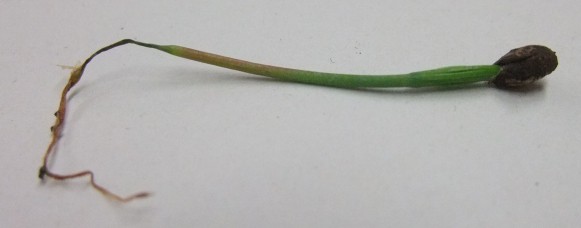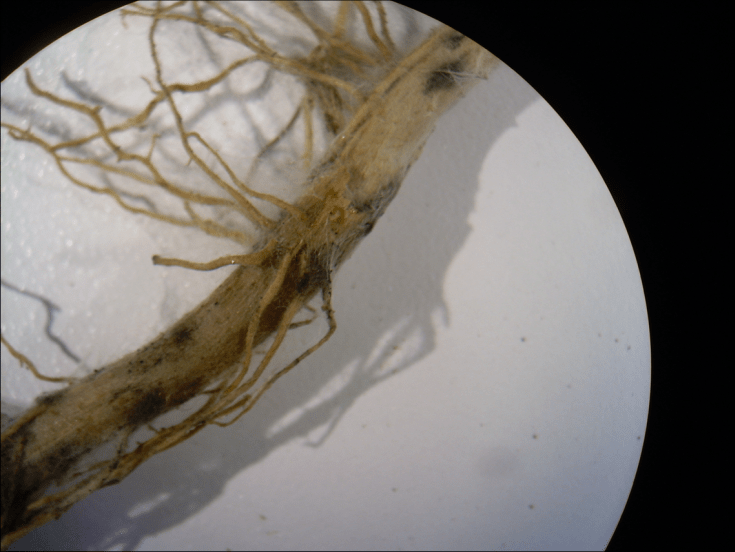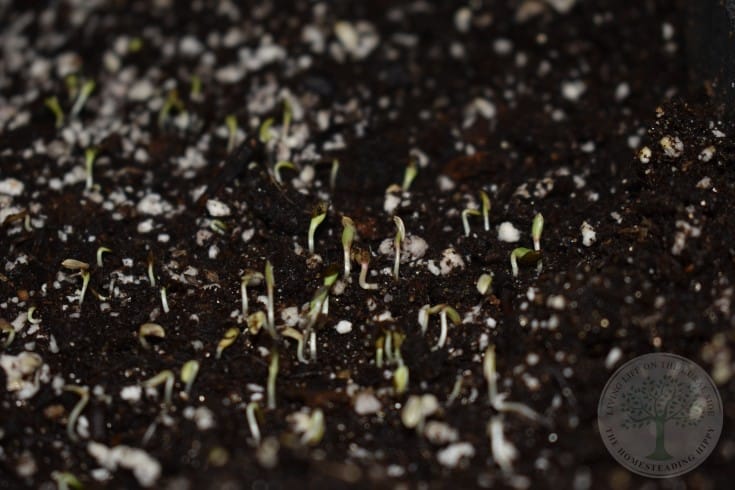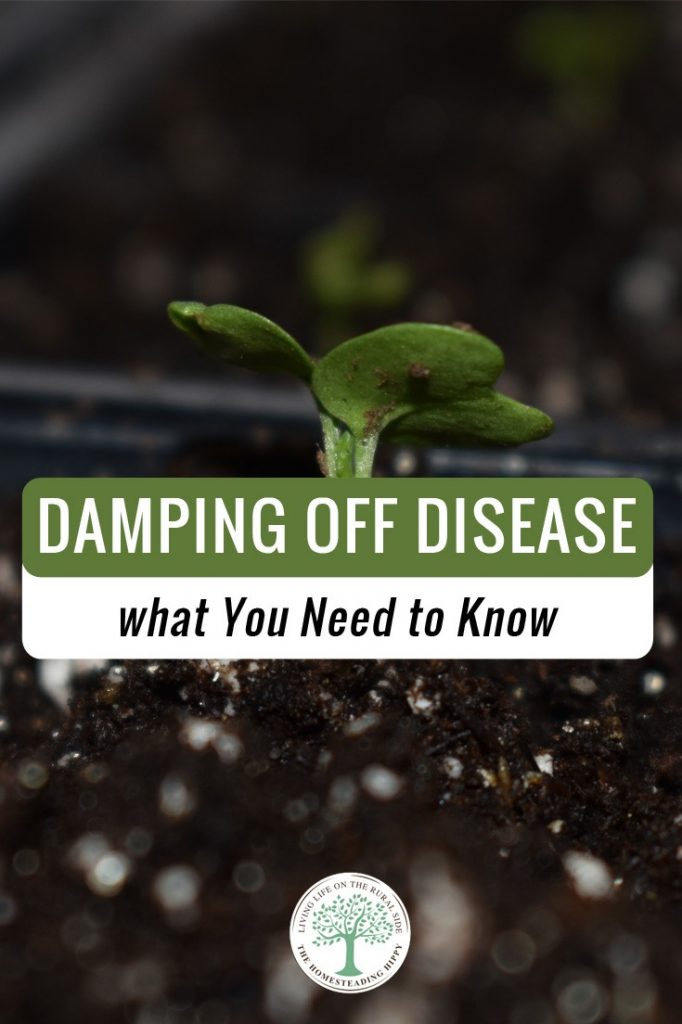There’s nothing quite as rewarding as starting your own seeds. This time of the year, it seems as though everywhere you turn, seed catalogs are peddling new seed starting equipment and seed varieties for you to try.
You don’t need a lot of fancy equipment in order to start your own seeds – but there is some information you need to know in order to get started.
Seedlings are generally tough little buggers, able to withstand just about anything you throw at them. Except for, that is, damping-off disease.

Table of Contents
What is Damping-off Disease?
Damping-off disease is the name of a soil-borne fungus that primarily affects seedlings. It attacks at the stem, causing it to rot away and for the root tissues at and below the soil line to disintegrate.
Common in young plants, the name for the disease is actually a bit of a misnomer. It doesn’t only include one kind of disease but can actually include several common fungal growths, including water mold and Fusarium.
Damping-off disease can affect all kinds of plants, including vegetables, flowers, and shrubs.
If you have an infected plant, you likely will not notice any sign of a problem until it has germinated, appeared, and then lived above the soil line for a few days first. Usually, the stems, leaves, and roots of the plant are the first to be affected.
Damping-off has the potential to kill an entire selection or an entire tray of seedlings. This can be incredibly frustrating, especially if you’re new to gardening and aren’t sure what you did wrong.
Mature plants can also be impacted by this disease, but the good news is that it is far less common than in seedlings.
Plus, once your plants develop strong root systems, they will be much better at resisting damages from this illness.
Symptoms of Damping-off Disease
You will know that damping-off disease is the problem you need to blame when you notice that these talks of your plants appear drenched in water, soggy, and thin.
They will also tip over at the base and begin to die back. Seedlings may turn somewhat brown or gray in color, and you may find fresh young leaves wilting and also changing colors.
Sometimes, you might even notice fluffy white growths (similar in appearance to cobwebs or mold) appearing on your plants.
When the plants finally die and you pull them up, you might notice roots that have either disappeared altogether, are stunted, or have discolored sunken areas. Sometimes, you may find that your seedlings failed to emerge at all.
Causes of Damping-off Disease
damping-off can be caused by a variety of pathogens, including mold and fungi. These can be introduced to the soil in a variety of ways.
The most common is when potting soil, potting tools, and pots themselves were used in prior seasons and not properly cleaned and stored.
In addition, spores of certain damping-off fungi can be blown in – if you are planting outside – or carried to your plants by fungus gnats. They can also be transported in the splashback of irrigation water.
Sometimes you can even give your plants damping-off disease, unintentionally, with your own hands.
If your hands have come into contact with donctmainted hose ends, tools, or other materials, it is very likely that you could introduce the spores to your plants.
In many cases, damping-off pathogens were already in the soil. These pathogens move rapidly from one plant to the next. It’s not a disease that’s limited to outdoor-grown plants but can also rear its ugly head in indoor-grown plants, too.
The disease thrives in cool, wet conditions. Any condition that inhibits plant growth – including poor fertility, too much salinity, cold soil, or low light conditions – can also increase the frequency and severity of damping-off disease.

How to Prevent Damping-off Disease
Use Sterile Potting Soil and Containers
Don’t reuse soil! Not only can this introduce soil borne pathogens to your containers – along with the fungi that caused the problems for you in the first place – but garden dirt is often devoid of the nutrients that seedlings need in order to get started.
You can reuse soil if – and only if – you sterilize it first this can be done by baking it out in the hot sun or by baking it in the microwave.
Just heat it on the highest setting possible for ten minutes. This will kill any contaminants that are lurking in the soil.
You should also be sterilizing your containers. Only use clean pots, and remember that even if they look clean, they might not be.
Fungal spores are invisible to the eye and can hide in the tiniest piece of potting soil. To sterilize your containers or seed starting trays, wash them using a combination of ten parts water to one part bleach.
Watch Your Conditions
Damping-off is not more common to one gardener than to the next, but it’s going to be a lot more difficult to treat and prevent it if you are a novice gardener.
That’s because new gardeners often aren’t familiar with best practices for planting and struggle with getting the right ratios of soil mixtures, temperatures, and moisture levels that seedlings need.
Ensuring that the soil is fertile and nutritious can also help boost your seedlings’ success and resistance to damping-off diseases, so make sure you brush up on all of your basic gardening needs and terminology before you start planting seeds.
Add Some Heat
When starting seedlings indoors, consider using a heating pad. This will warm the soil to at least 75 degrees, which will make it less likely that damping-off can occur.
Harden Off Seedlings
If you are transplanting seedlings outdoors, make sure you harden them off first. Wait until soil temperatures have risen to the appropriate levels for germination – usually a few weeks after the last frost – and then plant.
Avoid Early Fertilizing
Fertilizer can be helpful in preventing damping-off disease, but you’ll want to wait until the seedlings have developed true leaves. Then, you should apply it at a reduced rate than what you would use on a mature plant.
Practice Good Watering Hygiene
One of the easiest ways to prevent fungal issues -both in seedlings as well as in mature plants – is to watch how you water. Water from the bottom up so the seedling stays dry and only the roots get a drink.
Don’t overwater freshly started plants and consider poking additional drainage holes or adding drainage materials, like gravel, around the planting hole.
If you’re growing seedlings outside, you might want to consider investing in soaker hoses or drip irrigation systems to prevent your plants’ leaves from getting too wet.
Avoid watering past noon, too, which can increase the likelihood of fungal disease as the plants don’t have time to dry out.
Avoid Overcrowding
If you’re concerned that an outbreak of damping-off disease among your plants could decimate your entire growing operation, consider spicing things out a bit more.
This will not only prevent fungal issues like damping-off from occurring, but it can also help to prevent other fungal and bacterial diseases, too.
Plant With Circulation in Mind
When you plant your seedlings, try to sow them thinly. This will prevent overcrowding. If you are transplanting seedlings, do so with the soil surface near the top of the container. This will improve air circulation, too.
Consider Herbal Remedies
Some people swear by adding cinnamon or chamomile tea to their plants. Certain herbs and spices can help keep pests and diseases away, so watering your plants with these items can help prevent certain diseases.
You might also want to consider adding compost tea, which is loaded with helpful fungi and bacteria to get rid of pathogens. Plain old cinnamon can also be added to the soil.

Eliminating Damping-off Disease
Unfortunately, once you notice damping-off disease on your plants, there’s nothing you can do to salvage your plants. You need to let the seedlings die – and trust me, they’ll die really quickly – so that you can start all over.
Kill Any Sick Plants
Sadly, you’re going to need to cull the weaker members of the herd. Get rid of your seedlings if they are showing signs of damping-off.
It’s better to be safe and sorry here – you don’t want this disease spreading to the rest of your seedlings.
Use Hydrogen Peroxide
Again, you probably aren’t going to be able to save your damaged, infected seedlings – but you may be able to protect vulnerable seedlings by spritzing them with hydrogen peroxide.
Simply combine a splash of this chemical with a quart of water and lightly mist your feelings.
Add a Fungicide
Worst case scenario, you may need to use a fungicide to get rid of damping-off disease if it is a recurring, pervasive problem.
A chemical like Organocide can be applied to the soil as a drench or as a foliar spray. It won’t get rid of all damping-off-related pathogens, but it can prevent root rot and kill fusarium, among other types of diseases.
Don’t Panic
Unfortunately, damping-off disease is an ailment that most gardeners will have to deal with at some point or another.
While there’s not much you can do to combat it once it rears its ugly head, there are plenty of steps you can take now to prevent this issue from becoming a major problem later on down the road.


Rebekah is a full-time homesteader. On her 22 acres, she raises chickens, sheep, and bees, not to mention she grows a wide variety of veggies. She has a huge greenhouse and does lots of DIY projects with her husband in her ever-growing homesteading endeavor. Learn more about Rebekah here.
